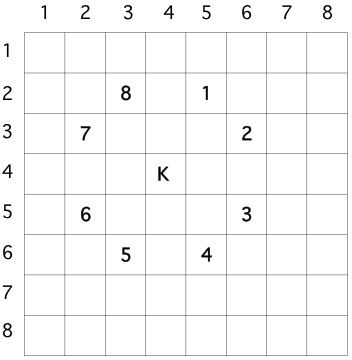The Swiss mathematician Leonhard Euler (1707 - 1783) proposed a problem regarding the movement of the knight chess piece on a chess board. The challenge that Euler proposed was to move the knight around an empty chessboard, and to touch each of the 64 squares once and only once. Directions: To start, move the knight from any position on the board using its standard L-shaped moves (two over in one direction, then one in a perpendicular direction). Practice on this empty grid. Number any position as 1 and then visit as many squares as possible, numbering each move as you go:
Your task in this lab is to write a program that will move a knight around an empty chess board, leaving behind a trail of increasing integers, ranging from 1 to, hopefully, 64. Here are the specifications for your assignment:
-
The knight will start in row 1, column 1.
-
The program will mark squares as they are visited, ranging from 1-64.
-
The program will continue until a complete tour is accomplished (all 64 squares) or the program gets stuck with nowhere to go.
-
The program will print the results, looking something like this:
1 2 3 4 5 6 7 8
1 1 0 21 0 0 14 23 12
2 20 0 6 9 22 11 0 0
3 7 2 19 36 15 46 13 24
4 0 5 8 47 10 37 0 45
5 0 18 3 16 35 44 25 38
6 4 31 34 0 42 39 28 0
7 0 0 17 32 29 26 43 40
8 0 33 30 0 0 41 0 27
47 squares were visited
-
Use the Random class to generate the necessary random numbers.
-
Here are two suggestions to solve this lab.
| Suggestion 1: |
Think about the 8 different possible moves a knight can make from a square. If we analyze them, we can break each one down into a horizontal and vertical component. |

Here are the 8 different possible moves analyzed as horizontal and vertical components:
| Move |
1 |
2 |
3 |
4 |
5 |
6 |
7 |
8 |
| horizontal |
+1 |
+2 |
+2 |
+1 |
-1 |
-2 |
-2 |
-1 |
| |
|
|
|
|
|
|
|
|
| vertical |
-2 |
-1 |
+1 |
+2 |
+2 |
+1 |
-1 |
-2 |
|
If you stored the above data in 2 arrays, called horizontal and vertical, it would be possible to move the knight to the next square using a statement like:
row = row + vertical[moveNumber];
col = col + horizontal[moveNumber];
This kind of approach will help to simplify your program.
| Suggestion 2: |
Declare the board as a 9 x 9 grid.
This will allow you to work with rows 1..8 and column 1..8. Row 0 and column 0 will not be used in this approach. |


